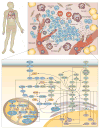Cancer Systems Biology: a peek into the future of patient care?
- PMID: 24492837
- PMCID: PMC4321721
- DOI: 10.1038/nrclinonc.2014.6
Cancer Systems Biology: a peek into the future of patient care?
Abstract
Traditionally, scientific research has focused on studying individual events, such as single mutations, gene function, or the effect that mutating one protein has on a biological phenotype. A range of technologies is beginning to provide information that will enable a holistic view of how genomic and epigenetic aberrations in cancer cells can alter the homeostasis of signalling networks within these cells, between cancer cells and the local microenvironment, and at the organ and organism level. This process, termed Systems Biology, needs to be integrated with an iterative approach wherein hypotheses and predictions that arise from modelling are refined and constrained by experimental evaluation. Systems biology approaches will be vital for developing and implementing effective strategies to deliver personalized cancer therapy. Specifically, these approaches will be important to select those patients who are most likely to benefit from targeted therapies and for the development and implementation of rational combinatorial therapies. Systems biology can help to increase therapy efficacy or bypass the emergence of resistance, thus converting the current-often short term-effects of targeted therapies into durable responses, ultimately to improve patient quality of life and provide a cure.
Conflict of interest statement
The authors declare no competing interests
Figures


References
Publication types
MeSH terms
Grants and funding
LinkOut - more resources
Full Text Sources
Other Literature Sources

